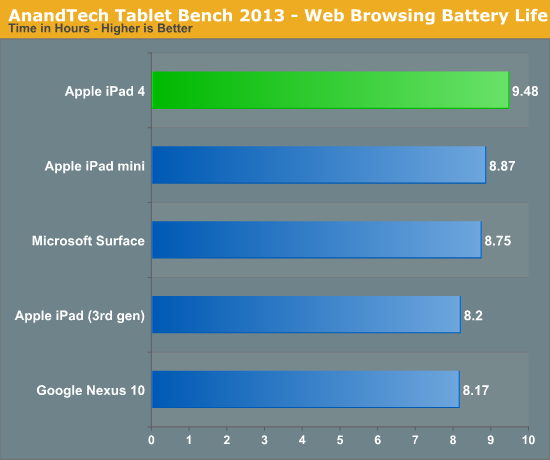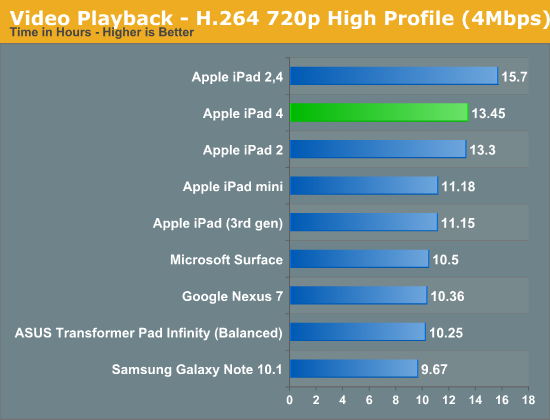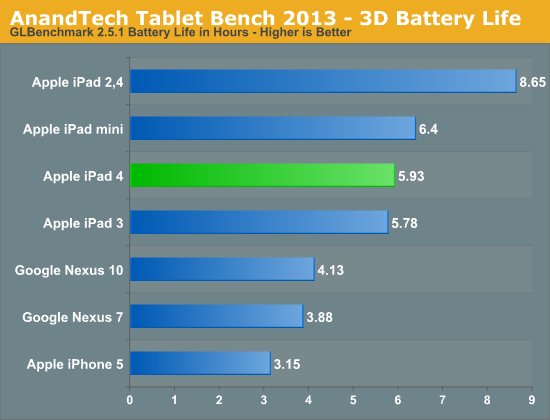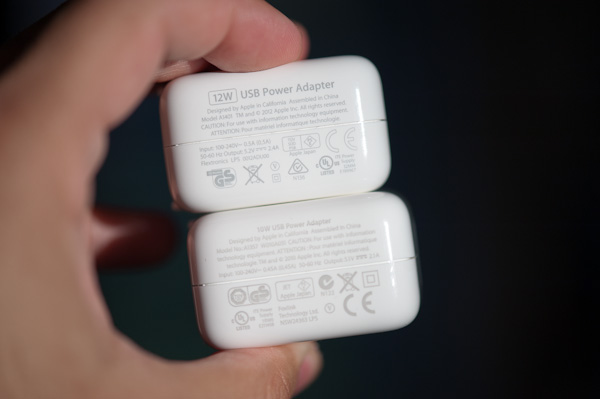iPad 4 (Late 2012) Review
by Anand Lal Shimpi on December 6, 2012 4:40 PM ESTCharging & Battery Life
The 4th gen iPad ships with a new 12W USB charger, a slight increase from the 10W model that shipped with all of the previous iPads. The new charger is no bigger than the previous version. Under max load the 12W charger will draw 13.57W at the wall. By comparison, the previous 10W model would pull a max of 12.44W. The 9% increase in power delivery does help shorten charge times a bit as it now only takes 5.69 hours for a complete charge (compared to ~6 with the old charger). It still takes a really long time to complete a full charge on the iPad, but without going to a larger power brick (or reducing the iPad's battery capacity) I don't see a simple solution here.

The iPad 4 is able to maintain charge equilibrium in the cases I tested, even under heavy load. With the 3rd generation iPad, if I ran Infinity Blade 2 while plugged in the total available battery charge would drop over time. On the 4th gen iPad, that no longer happens. I was able to maintain charge equilibrium even with the old 10W adapter on the iPad 4, pointing at overall power efficiency improvements rather than the new 12W adapter as the explanation for why this is now possible. It is possible that with fully loaded CPU and GPU cores that the new model wouldn't be able to maintain charge while powering the device, however I haven't encountered such a scenario yet.
Charge time isn't the only thing that improves with the 4th generation iPad. When Apple introduced the iPad 3, we saw a clear regression in battery life despite the much larger battery. I hate to sound like a broken record, but it's that same combination of power hungry display and big SoC that were responsible for the iPad 3's lower battery life. The iPad 4 doesn't ditch the display, but it does move to a 32nm LP HK+MG process for the SoC. Max power consumption should be higher thanks to the faster CPU/GPU cores, but given the same workload we should see a tangible improvement in battery life (similar to what we saw with the iPhone 5). We went through our standard suite of battery life tests to find out how things have changed since the iPad 3.
We've started running our new smartphone web browsing battery life test on tablets as well. If you missed its introduction in our iPhone 5 review, here's a bit about the new test:
We regularly load web pages at a fixed interval until the battery dies (all displays are calibrated to 200 nits as always). The differences between this test and our previous one boil down to the amount of network activity and CPU load.
On the network side, we've done a lot more to prevent aggressive browser caching of our web pages. Some caching is important otherwise you end up with a baseband/WiFi test, but it's clear what we had previously wasn't working. Brian made sure that despite the increased network load, the baseband/WiFi still have the opportunity to enter their idle states during the course of the benchmark.
We also increased CPU workload along two vectors: we decreased pause time between web page loads and we shifted to full desktop web pages, some of which are very js heavy. The end result is a CPU usage profile that mimics constant, heavy usage beyond just web browsing. Everything you do on your device ends up causing CPU usage peaks - opening applications, navigating around the OS and of course using apps themselves. Our 5th generation web browsing battery life test should map well to more types of mobile usage, not just idle content consumption of data from web pages.

I no longer have a 45nm iPad 2 so forgive me for the incomplete dataset here (it's safe to say that the iPad 2 would at least equal the iPad 4 in battery life, if not exceed it), but battery life has improved appreciably since earlier this year. The iPad 4 lasts around 15% longer on a single charge compared to the 3rd gen iPad. It also edges out the iPad mini and Microsoft's Surface. There's a good advantage over the Nexus 10 as well, but all of these tablets have smaller batteries than the iPad 4..
We haven't yet rerun our new test on all of the tablets, so we turn to our older 4th gen test to provide some additional reference points:

Here we see that although Apple has improved things, the iPad 4 still remains behind the old iPad 2's battery life target. Also note that in a lighter CPU workload where the iPad 4's Swift cores aren't asleep for substantially longer than the iPad 3's Cortex A9s, the difference in battery life ends up being pretty minimal.
Our video playback test remains unchanged from previous tablet reviews. Here I'm playing a 4Mbps H.264 High Profile 720p rip I made of the Harry Potter 8 Blu-ray. The full movie plays through and is looped until the battery dies. Once again, the displays are calibrated to 200 nits:

Video playback battery life has finally surpassed that of the iPad 2. As we saw with our camera analysis, Apple did some work on the video encode hardware/software this generation - it's also possible that the decode path saw an improvement as well. The 32nm iPad 2,4 still remains the king of this test but that's a bit of an anomaly. It's rare that we see a pure die shrink with no added performance/features offered these days.
Our final cross-platform battery life test is the new GLBenchmark 2.5.1 Egypt HD test. Here we have a loop of the Egypt HD benchmark, capped to 30 fps, running on all of the devices with their screens calibrated to 200 nits.

The results here actually surprised me a bit, but they make sense when you think about them. Capped at 30 fps (like many heavy iOS games are) the 4th generation iPad actually has GPU performance to spare in the Egypt HD test (avg frame rate is 40 fps vs. 21 fps for the iPad 3). Despite the fact that the 4th gen iPad has a more power hungry GPU, that extra performance remains partially unused which, when combined with the more power efficient 32nm LP process, gives the new iPad a slight edge in gaming battery life. Note that this only applies to the situation where the workload is identical between the iPad 3 and 4. Earlier I showed that some games actually put the increased shader power to good use and increase image quality. In these cases where the iPad 4 is doing more physical work than the iPad 3, you may see no improvement in battery life or even a regression.
Thermals
The display and backlight in the 3rd generation iPad, combined with the large 45nm SoC, resulted in a tablet that got pretty warm under load. The 4th gen model doesn't do away with the display but it does move to silicon that can drive to low power sleep states quicker than before (given the same workload). The result is a tablet that has the potential to run a bit cooler depending on what you're doing with it.
Under full load however there's no getting around the fact that both the CPU and GPU cores are significantly faster than their predecessor. Running Infinity Blade 2 for an hour produced slightly higher surface temperatures on the iPad 4 vs. the iPad 3:
| Thermal Comparison - iPad 3 vs. 4 - Infinity Blade 2 Loop (1hr) | ||||
| Temperature Measurement Location | Apple iPad 4 | Apple iPad 3 | ||
| Back of Tablet, Apple Logo | 35.7C | 34.4C | ||
| Back of Tablet, Hottest Point | 39.9C | 39.1C | ||
The difference isn't huge and it's only noticeable if you switch between the two tablets, but there's no real improvement in worst case thermals. The iPad 4 remains one of the warmest tablets that I've used. It doesn't get uncomfortably hot but I would prefer a cooler running device. Unfortunately until we see a big improvement in display power consumption, I just don't know how that will be possible. The move to 20nm won't happen anytime soon.











113 Comments
View All Comments
darkcrayon - Friday, December 7, 2012 - link
Ok that was pretty funny. "When you need paper that gets stuff done".Most documents in existence electronically are closer to a 3:4 aspect ratio. I'm sorry, but it's true. And they will fit an iPad sized screen more conveniently. But please, feel free to show me the treasure trove of ready made documents that are 9:16 or even 10:16 long.
Also, show me the benchmarks where the Nexus 10 GPU is better than the iPad 3 - not that that disproved my point. The one in the iPad 4 is quite a bit more powerful, so it's a legitimate area where the Nexus 10 is *not* a "much better tablet". And of course don't even get us started on 10" Android tablet apps.
ltcommanderdata - Thursday, December 6, 2012 - link
Any estimate on the SGX554MP4 clock speed? Since the 16% pixel fill performance difference is supposed to be largely clock speed related and the iPad 3's SGX543MP4 was clocked at 250MHz, that works out to 290MHz. Previous Apple SoC used a 4x multiplier between CPU and GPU. If the A6X changed to a 5x multiplier, then a 1.4GHz CPU works out to a 280MHz GPU, which seems to match what is being seen here.And process improvements for SoC power and thermals don't have to wait for 20 nm. Samsung has a 28 nm process, which they claim uses the same design rules as their 32nm process allowing a quick and easy transition, while offering power or performance benefits over their 32 nm process. I'm guessing 2013 iDevices will use a combination of shrinks and new SoC on the 28 nm Samsung process, which with all the TSMC rumours, may be the last SoC Apple makes with Samsung. 2014 iDevices would then use TSMC 20 nm.
Krysto - Thursday, December 6, 2012 - link
So it seems that in terms of gaming performance (which is really what matters when you evaluate a GPU), the devices compare as it follows:Ipad 4, Nexus 4 and iPhone 5 have the same performance in games - compared as devices, running at their own native resolution.
http://images.anandtech.com/graphs/graph6472/51760...
As for the GPU's themselves, it seems the A6X GPU is 42% faster than Mali T604, while Mali T604 and Adreno 320 are about 10-20% faster than the A6 GPU (iPhone 5), and than the A5X GPU (iPad 3)
http://images.anandtech.com/graphs/graph6472/51761...
coder543 - Thursday, December 6, 2012 - link
from one perspective. Honestly, benchmarks are just benchmarks. I'd agree with that assessment as far as these benchmarks go though. I'm not sure how much it matters -- suffice it to say they're all very fast.Alucard291 - Sunday, December 9, 2012 - link
Very slow surely? As this is STILL about 10 years behind desktop gpu'sltcommanderdata - Thursday, December 6, 2012 - link
Well the Nexus 4 having the same gaming performance as the iPad 4 and iPhone 5 depends on how often people take their phone into a freezer to play games.michal1980 - Thursday, December 6, 2012 - link
amazing. Apple must be paying for this coverage, and it was a week or two ago I was told that something was coming soon.should have figured, another sligthly updated apple product
darkcrayon - Thursday, December 6, 2012 - link
Just as we should've figured you'd be in the comment section whining about it ;)vision33r - Thursday, December 6, 2012 - link
Why would Apple be interested in marketing to PC enthusiasts on a site like this? It's a waste of money if they did pay Anand.In case you ever opened a male or female fashion mag or financial magazine, Apple advertisements are everywhere. Clearly they are more interested in marketing towards rich casual computer users.
So your theory of Apple paying for this coverage as usual trolling and Apple hating. That's ok, they don't mind you hating them on a website they have little interested marketing on.
pliablemoosethebanned - Thursday, December 6, 2012 - link
Yep, Anand needs to focus more on crap products like the Surface tablet.